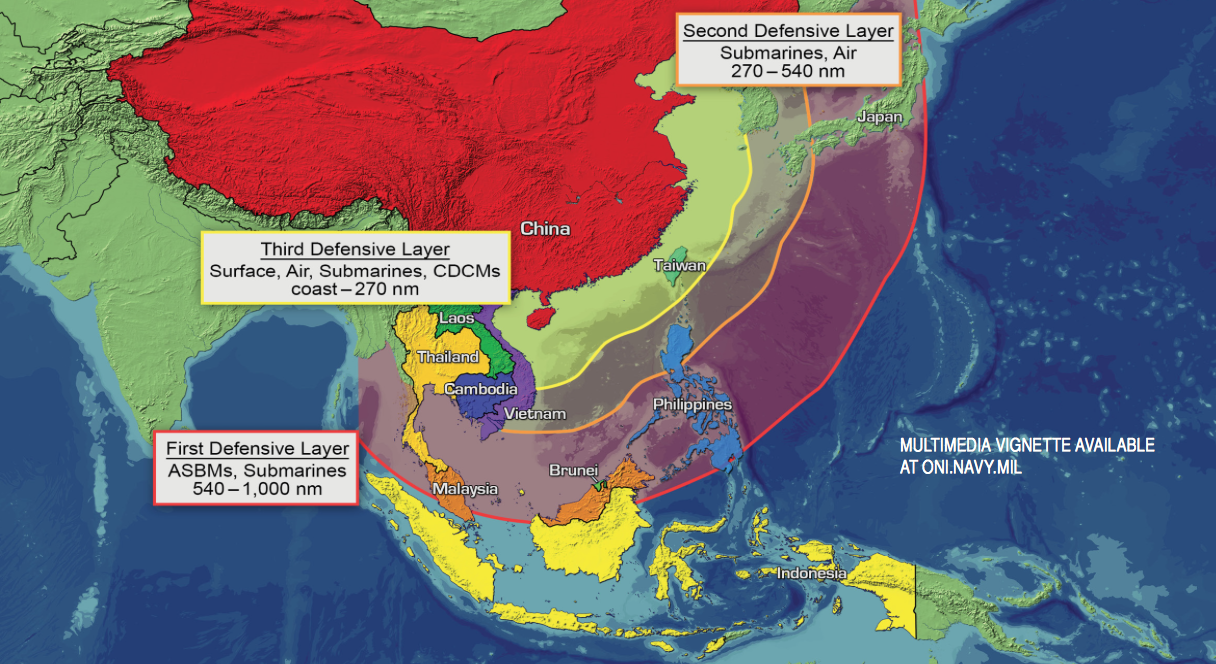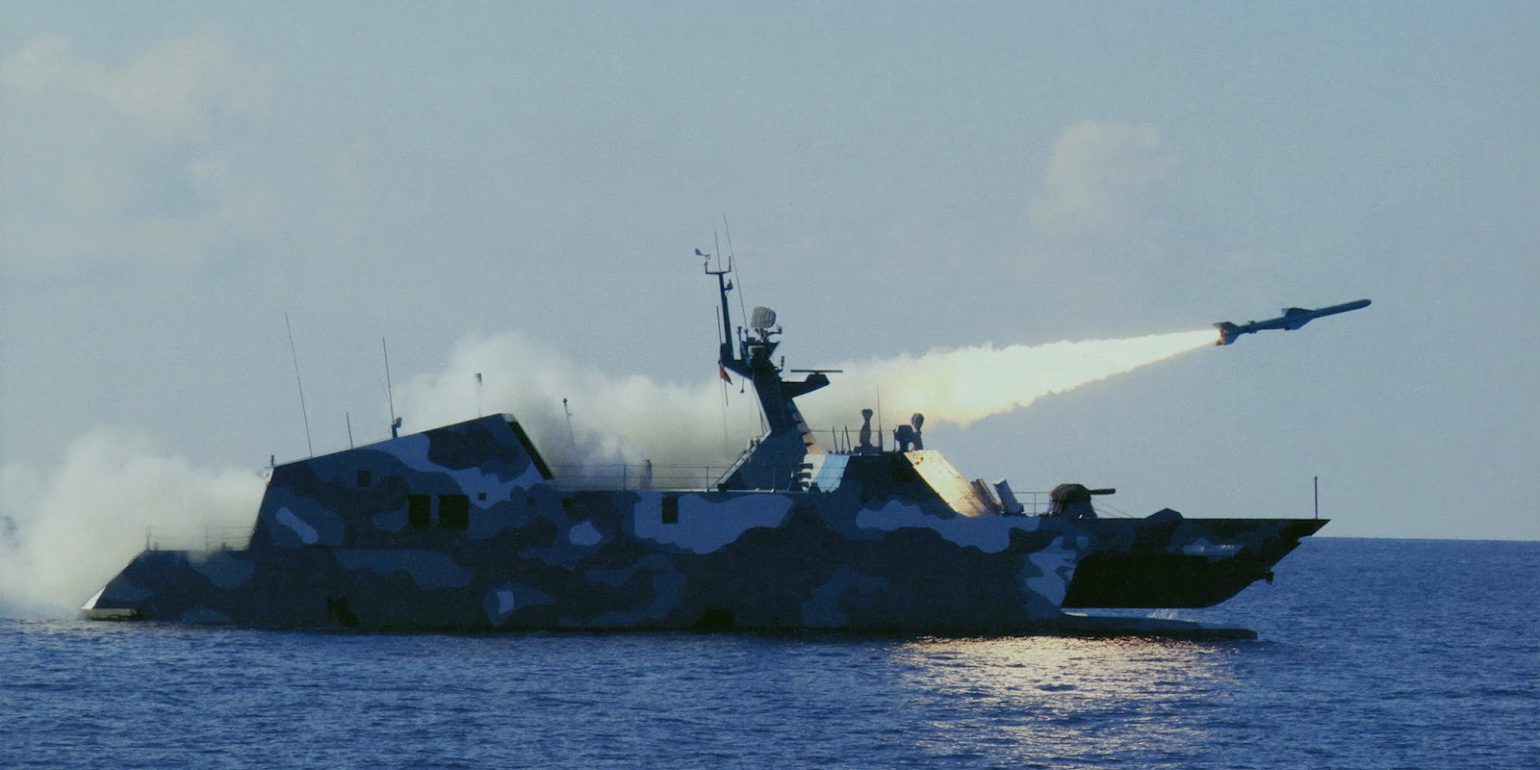A Chinese fast-attack vessel launches an anti-ship cruise missile
What is Anti-Access/Area Denial (A2/AD)?
A2/AD is an attempt to deny an adversary’s freedom of movement on the battlefield. Anti-access –of enemy military movement into an area of operations – utilizes attack aircraft, warships, and specialized ballistic and cruise missiles designed to strike key targets. Area denial – denial of enemy freedom of action in areas under friendly control – employs more defensive means such as air and sea defense systems.[i]Because modern military technology is required to uphold A2/AD, it is almost exclusively practiced by advanced regional powers such as Russia and China. Recently, these powers have employed A2/AD in disputed regions like Crimea and the South China Sea to disrupt freedom of navigation for the United States and the international community. Russia and China’s use of A2/AD directly opposes the local and regional interests of the U.S. and its allies, leaving us vulnerable when operating in these disputed regions.
Importance of A2/AD
The ability to project our military power and surge forces globally are vital to the United States’ status as a superpower and the credibility of our overall national security strategy. Amid endemic budget cuts, in September 2014 Secretary of Defense Chuck Hagel unveiled a “Third Offset” strategy to “[maintain] our ability to project power globally, to deter potential adversaries and reassure allies and friends despite the emergence of A2/AD threats.”These A2/AD threats impede our ability to project power, thus presenting a significant vulnerability.
Chinese A2/AD
Recently, China has emerged as an assertive regional power in the Asia-Pacific with forceful A2/AD capabilities, using advanced ballistic and cruise missiles in conjunction with air and maritime defense systems to deter U.S. military operations in the region. China’s A2/AD is concentrated around Taiwan and the South China Sea, putting U.S. military forces—such as a Carrier Strike Group—and installations in the region within range of precision-guided cruise and ballistic missiles. This regional A2/AD threat also severely mitigates the ability of U.S. forces to conduct operations in the Asia-Pacific. For anti-access, China relies on advanced land-attack ballistic and cruise missiles to threaten U.S. military facilities on the islands of Okinawa and Guam. Also employed are anti-ship cruise and ballistic missile variants, which, using advanced re-entry vehicle technology, have the capability to strike with precision and bypass most sea-based missile defense platforms. China’s anti-ship cruise missiles are fielded by warships, submarines, and aircraft that patrol the waters along the country’s coastline. The air-launched YJ-100 is China’s longest range ASCM with a range between 650 and 800 km. Other advanced anti-ship cruise missiles in the Chinese arsenal are the Yj-12 and YJ-18 supersonic missiles, with ranges close to 500 km. China’s land-attack cruise missiles are air- and ground-launched, with ground-launched variants having a range exceeding 1,500 km. [ii]
China relies on fighter aircraft and an intricate network of air and missile defense platforms for area denial, employing defensive systems produced indigenously as well as Russian-built S-300s.[iii]These defense systems and fighter aircraft are employed to deny U.S. airpower and the use of cruise missiles in the region. China continues to improve its area denial capabilities and reports speculate that the country plans to acquire improved S-400 air defense systems from Russia for deployment in the region.[iv]Anti-satellite weapons are also believed to be employed by China to maintain A2/AD in the Asia-Pacific, and would be used to disrupt or even completely deny U.S. satellite communication and GPS capabilities.[v]
Chinese Air and Missile Defense Systems
| System | Deployment | Range |
| HQ-7 | China, Algeria, Bangladesh, Iran, Pakistan, and Turkmenistan | 12 km (HQ-7); 15 km (HQ-7B) |
| HQ-9 | China, Algeria, Bangladesh, Iran, Iraq, Pakistan, and Turkmenistan | 100 km (FT-2000); 200 km (HQ-9); 250 km (HQ-9A); 300 km (HQ-9B) |
| HQ-12 | China, Malaysia, Myanmar, Thailand, Turkmenistan, and Uzbekistan | 50 km (HQ-12, KS-1A); 70 km (KS-1C); 170 km (HQ-22) |
| HQ-15 | China, Greece, Slovakia, and Vietnam | 45 km (5V55K missile); 75 km (5V55R missile); 150 km (48N6 missile); 200 km (48N6ER missile) |
| HQ-16 | China and Pakistan | 40 km (HQ-16); 70 km (HQ-16B and HQ-16C) |
| HQ-17 | China, Cyprus, Egypt, Greece, Iran, Ukraine, and Venezuela | 12 km |
| HQ-18 | China, Belarus, Egypt, Iran, and Venezuela | 100 km (9M82 missile); 40 km (9M83 missile) |
| HQ-19 (not yet operational) | N/A | 3,000 km |
| HQ-26 (not yet operational) | N/A | 2,000 km |
| HQ-29 (not yet operational) | N/A | N/A |

China’s A2/AD bubble in the South China Sea and the Pacific Ocean
U.S./Allied Countermeasures
U.S. military strategy and planning is beginning to recognize the threat posed by China’s A2/AD capabilities and new risks are being considered when planning operations in the Asia-Pacific region. The 2010 Quadrennial Defense Review (QDR) states that U.S. military forces need to be able to maintain power projection in anti-access regions to “deter, defend against, and defeat aggression by potentially hostile nation states.”[vi]Initial U.S. efforts to counter China’s A2/AD have emphasized enhanced joint force cooperation in contested regions, as well as improved and more cost-effective air and missile defense technologies for regional and theater defense. In 2013, the United States deployed a THAAD battery to Guam to protect military assets stationed there. Around the same time, the United States permanently deployed Patriot/PAC-3 batteries to its military base in Okinawa, Japan.[vii]Additional protection against the Chinese missile threat comes from sea-based defensive platforms.
Currently, the United States has 17 Aegis BMD-capable vessels—equipped with SM-3 interceptors—deployed in the Pacific for defense against ballistic missiles. Cruise missile defense for U.S. maritime forces is provided by Aegis vessels equipped with SM-2, SM-6, and ESSM interceptors. While effective for layered missile defense, these sea-based platforms are not designed or equipped to defeat large missile salvos. Consequently, China could oversaturate these missile defense systems with relative ease by attacking with large numbers of anti-ship ballistic and cruise missiles. To counter missile salvos, new technology is being researched and tested. Particularly promising options are directed energy systems, electromagnetic railguns, electronic countermeasures, and cost-effective kinetic interceptors.
Click here to visit our China webpage for more in-depth information on China’s capabilities.
Recent News
Sources
[i]Krepinevich, Andrew, Barry Watts and Robert Work. “Meeting the Anti-Access and Area-Denial Challenge.” Center for Strategic and Budgetary Assessments.
[ii]Gormley, D., Erickson, A., and Yuan, J., “JFQ 75: A Potent Vector: Assessing Chinese Cruise Missile Developments.” National Defense University Press. http://ndupress.ndu.edu/Media/News/NewsArticleView/tabid/7849/Article/577568/jfq-75-a-potent-vector-assessing-chinese-cruise-missile-developments.aspx.
[iii]Major McCarthy, Christopher j. “Anti-Access/Area Denial: The Evolution of Modern Warfare.” https://www.usnwc.edu/Lucent/OpenPdf.aspx?id=95.
[iv]Ibid.
[v]Ibid.
[vi]Ibid.
[vii]“Patriot units to be deployed in Okinawa permanently.” The Japan Times. http://www.japantimes.co.jp/news/2013/04/13/national/politics-diplomacy/patriot-units-to-be-deployed-in-okinawa-permanently/#.V4O4-rgrLIV.

